Dead ends, thundering traffic and road surfaces that resemble the surface of the moon. It’s no exaggeration to say that your cycling route planning can make or break an enjoyable ride.
When you’re on holiday it’s really important to have a cycle route plan before pedalling off for the day. There’s nothing worse than wasting your precious holiday time getting lost, constantly having to check your directions or unwittingly cruising the less enjoyable roads of the area.
Even when close to home it’s worth taking the time to plan a cycling route that maximises your smiles per mile!
A little time invested in cycling route planning goes a long way. This article will share the lessons we’ve learnt the hard way and help you find your perfect route, with quiet, spectacular roads where you can get the best out of your riding.
A big thank you to the Patronat de Turisme Costa Brava Girona for sponsoring this article.
They want to make sure cyclists get the most out of any ride, particularly when it’s in the world-class cycling destination that is Girona and the Costa Brava.
Want to know more about cycling in Girona/Costa Brava? Check out our guides and the Tourist Board’s sites on cycling and training camps.
Don’t fancy planning your route/want some local help? Check out Girona’s local tour operators.
Part 1: How to plan a cycle route
Map v cycling route planner app
For most of us, the days of spreading out a 1:50,000 Ordnance Survey map on the kitchen table are long gone.
But picking up an old-school physical map can give you the perspective and detail that is more difficult to discern when you plan a bike route using an app or website.
Maps
Physical maps have a number of key advantages when trying to piece together the best routes.
A good map will clearly differentiate between the different classes of roads. The narrower are lost lanes/very minor roads – too narrow to allow two cars to pass each other, meaning that will cars avoid them or (hopefully!) travel slowly.
Your eye will also more quickly be drawn to points of interest – viewpoints, historic buildings and great places to stop for a coffee or bite to eat. These are all important components of a well-planned ride!
For Girona Costa Brava, we particularly like the Road Cycling Map by GeoNomada, 1:110,000 of Girona, Pirineus and Costa Brava.
Route planner websites/apps
On the other side of the equation, route planning websites and apps have the obvious advantage of speed and doing a lot of the legwork for you.
It can be as simple as plugging in your start and end points and the route planning app will draw an optimised route that you can review, tweak and add stopping points to.
You’ll get accurate distance information and can even get an idea of how long it will take to complete the route, based on an average speed. You can then optimise to find shortest routes, add in more hills, viewpoints etc…
If you’re going to Girona Costa Brava, you’ll find the Tourist Board’s tried and tested pre-plotted routes a really useful starting point (more on that below).
Looking for the best cycling apps? This article shares our favourites.
A happy medium?
If you’re really meticulous and can’t bear to bin the physical map, you could use a cycling route planner app to create a first draft of the route, then finesse it using an old-school map…
In reality, it’s likely most of us are wedded to our planner apps/websites and can’t imagine life without them these days!
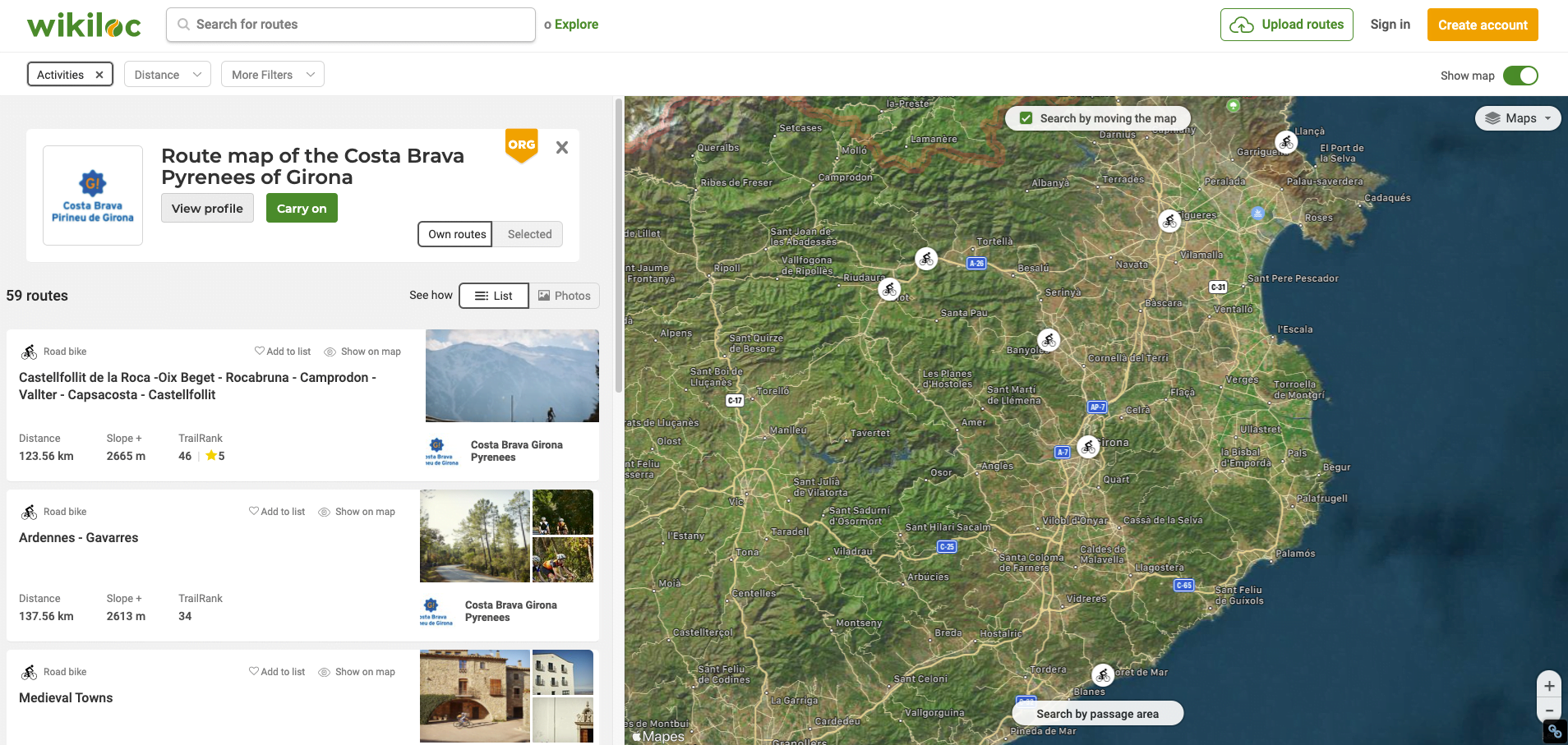 Costa Brava Tourist Board’s Wikiloc page with pre-planned cycling routes
Costa Brava Tourist Board’s Wikiloc page with pre-planned cycling routesComparison of the best cycling route apps
Many apps allow you to plot and/or follow cycling routes. There is a bewildering array and all come with a diverse selection of route planning features. Examples include:
Bikely.com, Bikehike, Cycle.travel, EasyRoute, GPSies, Garmin Connect, Google Maps, MapMyRide, MAPS.ME, PlotaRoute, Ride with GPS, Strava and Wikiloc.
The million-dollar question is – which is the best cycling route planner app to use?!
Ride with GPS
Our personal favourite is Ride with GPS, which offers a very clear and intuitive interface for plotting routes.
- We find the route profile/elevation profile information really useful, as it gives you a graph showing your route, complete with gradients, that’s really useful for giving you an idea of how tough your ride is going to be (and where).
- There’s estimated ride time information, though we tend not to pay too much attention to that as it’s very dependent on fitness and how much you stop.
- There are lots of other nice little features – for example, you can choose the map type you want to use as the base map, whether you see the metrics in Imperial or Metric measurements and you can also save your favourite routes to re-use later.
- Ride with GPS has also got great connectivity with Wahoo and Garmin bike computers, which makes uploading the route to your computer really easy. The phone compatibility isn’t bad either!
- In terms of route plotting, we’ve found it pretty reliable, though we prefer to use the ‘car setting’ most of the time when plotting as in the ‘cycling setting’, we find it is a very firm advocate of cycle paths, even when they’re not suitable for road bikes!
Google Maps
We also find that Google Maps (with the cycling setting) is good for a spot check or if you have a smart phone mount. The fact it’s free, easy to use and works in 200+ countries makes it very convenient. Bear in mind:
- There’s no route building option – you’re given the route and the most you can do is add a few interim stops.
- It sometimes won’t let you use a road, for example because it’s closed in winter when you’re searching.
- The estimated time of arrival might not always be accurate.
- Google Maps is a canvas for mapping search results and advertising results, which may be a benefit to you or may annoy you, depending on your view on life!
Wikiloc
If you’re riding around the Girona Costa Brava region, it’s worth taking a look at Wikiloc. It’s one of the most popular apps in Spain for route planning and covers all sorts of outdoor activities. It’s worth knowing:
- You can use the app to create a route or record your own routes on a map, add waypoints, take pictures along the itinerary and upload them to your Wikiloc account from your phone.
- There are millions of routes on this site. A great way to find the high quality ones is to search for the tourist board for the region you want to visit, as they’re likely to have a profiles where they share their routes (inc GPX files you can download). These can be an excellent source of route inspiration.
- Girona Costa Brava’s profile is here – you can filter by road cycling to see their route suggestions.
- Note that use of some of Wikiloc’s enhanced features require you to pay for the premium version.
Strava
Every cyclist knows about Strava – but to plan a route on Strava, you need Strava Premium.
However, a search of Strava’s heatmaps can be useful for identifying popular routes with cyclists (though again, you’ll need a Premium plan to access your own heatmap). And, of course, the Strava segments are good to incorporate – if you’re into that kind of thing.
 Girona Costa Brava region on Strava heat maps (standard view)
Girona Costa Brava region on Strava heat maps (standard view)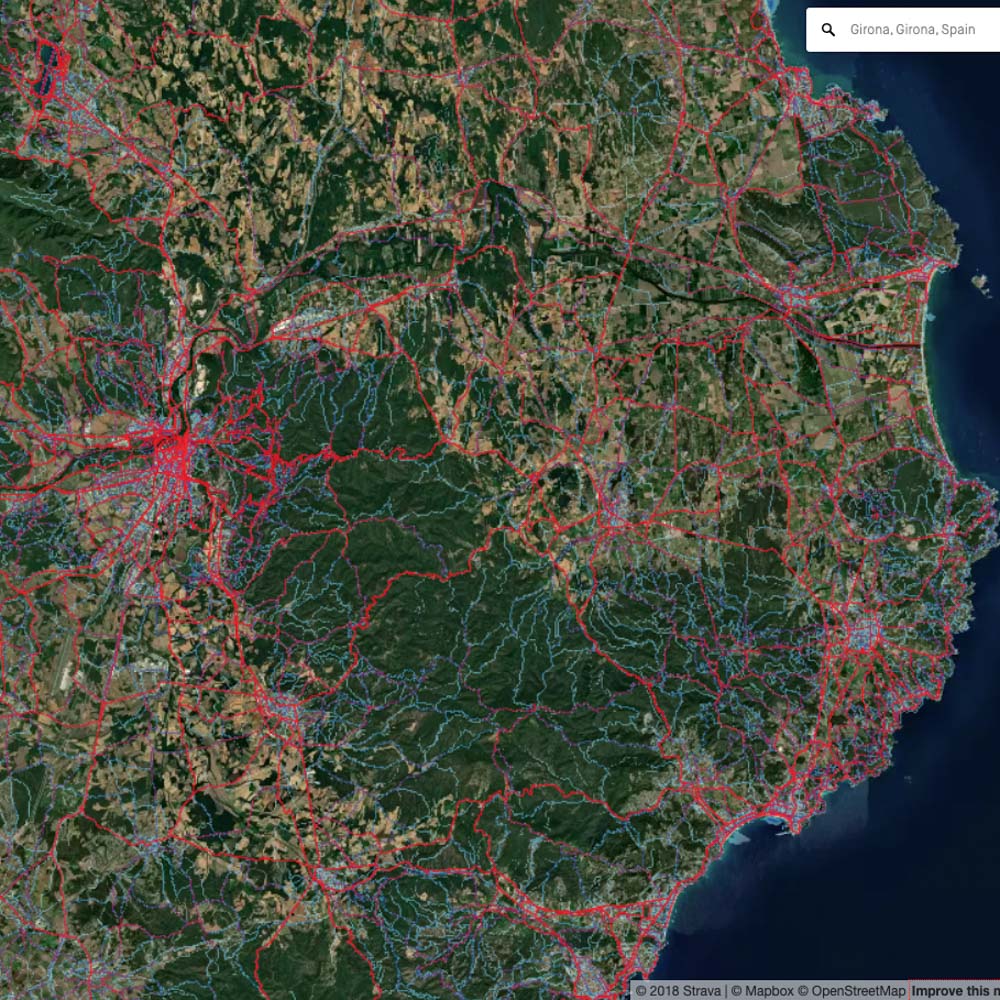 Girona Costa Brava region on Strava heat maps (satellite view)
Girona Costa Brava region on Strava heat maps (satellite view)How route planner cycling apps pick their route
For those that like geeky detail, it might be useful to know how the cycling route creator apps come up with their routes.
The basic position is that each app scores every path and road for its suitability for cycling.
So when you plan a multi-stop bike route, the cycle planner optimises the route between specified points to achieve the best score. They take data from:
- Map data source: There are only four widely used global data sources, with Google Maps and Open Streetmap being the most widely used for cycling.
- Traffic counts: The more sophisticated apps will overlay the map data with data on traffic levels. For example, a rural road in the Girona Pyrenees may be wonderful to ride (despite being marked as a major road), but a busy commuter B road in central Girona might be much less fun. So a planner that takes into account traffic data (where it’s available) will try to avoid the more trafficked roads to maximize your safety and enjoyment.
This is why choice of route varies between planners and why, depending on the route planner used, there can be a number of key differences in the route that’s suggested.
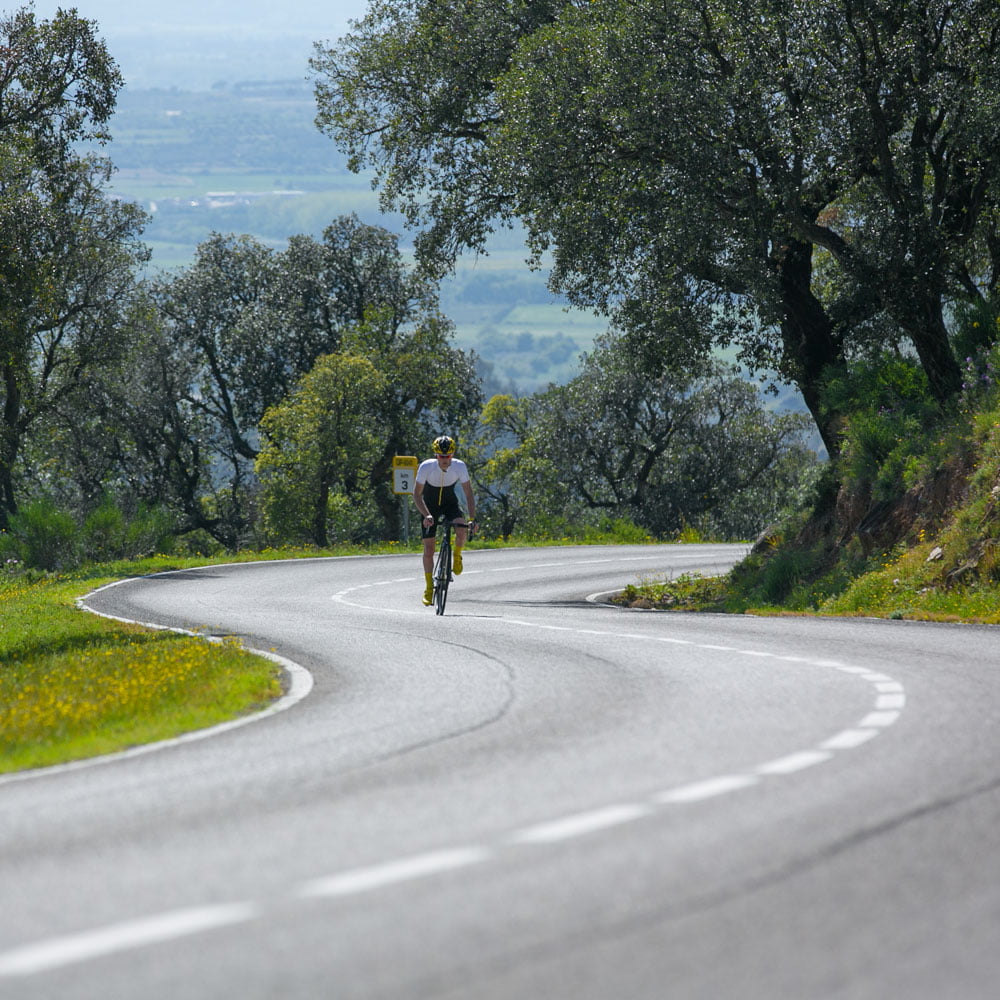 The kind of road you can expect to ride in the Costa Brava (photo credit: footnote 2)
The kind of road you can expect to ride in the Costa Brava (photo credit: footnote 2) Santuari dels Àngels (photo credit: footnote 3)
Santuari dels Àngels (photo credit: footnote 3)
Tips for planning a route by bike
It’s safe to say we’ve planned many, many routes. Here are our top route planning tips:
Desktop not mobile
We’d suggest using a computer to plan your route. If you’ve ever tried to use a route planner for cycling on a smartphone, you will find that even the deftest fingers and largest iPhone screen can’t compare to using a full-sized computer screen and mouse or trackpad!
Use the right route planner
Before investing loads of time in planning a bike route, make sure you think about how you’re going to use it. Are you using the best cycling route app for how you want to use it? For example, can you easily access the route in the correct format for free on the device you want to use or will you have to pay for a premium option?
Common glitches
Apps and websites can help you create a cycling route quickly and efficiently. By all means make use of this, but like in any good sci-fi film, the human needs to keep a firm hand on the machine.
While the functionality and flexibility of bike route planners is improving, there are some things to look out for before you finalise your route and transfer it to your bike computer:
- Unpleasant sections: A quick scan of the suggested route should reveal whether there are avoidable sections on major roads that may get too close to cities, have heavy traffic, or intimidating traffic junctions that can de detoured.
- Crazy gradients: Mapping software may not pay much attention to steep gradients (uphill or downhill) that you might want to avoid (or perhaps hunt out for extra challenge!). When you map a cycling route, the profile and statistics allow you to easily identify and adjust your route to allow for climbs.
- Town centres: When you plan a bicycle route, you probably want to go through the centre of some villages/towns rather than around the edge, which the route planner may favour.
- Stopping points: Bear in mind that cycle route planner apps won’t consider incorporating the best cafés, viewpoints and food/drink stops into the route.
- Bike trails: Selecting to use bike route overlays can favour routing via bike lanes and sometimes unpaved roads over paved roads. Many routes identified as bike lanes in mapping tools are off-road trails that are okay for mountain bikes or leisure cycling but are not suitable for skinny-tyred road bikes.
Cross-referencing
If you’re planning a particularly important route, it might be worth taking these extra steps:
- Compare the route with reality: If you’re testing a new ride planner, you could see what you think of it by plotting a journey you regularly do and know. You could then look at what the planner has suggested and see how it corresponds. What the route planner has come up with could be better than what you normally do! Or it could reveal the biases of the bike route planner app.
- Google Street View: it’s a fantastic tool for figuring out whether a road is a suitable road route – is the surface good and is it suitable for cycling? Likewise, we’ve heard great things about geograph.org.uk – though bear in mind that it’s only for Great Britain and Ireland. We’ve not used it much ourselves, as it’s most useful for those wanting to go off-road and hasn’t got the nicest interface in the world.
- Perfect your ride: Every now and again you can find that your routing didn’t quite work out. Make a note to go back and adjust your GPX file for next time – before you forget about it!
 A stop on Lake Banyoles is exactly the sort of thing you’ll want to incorporate into your ride if you’re in the Costa Brava (photo credit: footnote 4)
A stop on Lake Banyoles is exactly the sort of thing you’ll want to incorporate into your ride if you’re in the Costa Brava (photo credit: footnote 4) A coffee stop is always a good idea, particularly when it’s coffee as good as this! (La Fabrica, Girona) (photo credit: footnote 5)
A coffee stop is always a good idea, particularly when it’s coffee as good as this! (La Fabrica, Girona) (photo credit: footnote 5)Part 2: Shortcuts + hacks for cycling route planning
We spoke at the start about how important it is to plan a great cycling route. But, let’s be honest, all that plotting, checking and cross-referencing is not everyone’s idea of a fun way to spend a few hours! Especially if you’re looking for routes to ride while on holiday.
So, how can you avoid having to spend time on route planning?!
Find a (good quality) pre-plotted route online
As you know, here at epicroadrides.com we’ve made it our mission to curate the best rides that are available to download for free. The site covers many of the world’s best cycling destinations, but don’t expect the same coverage as one of the websites like Strava or Komoot that collate user-generated rides. Ours is a curated collection of rides we’ve ridden and loved (for example on Girona, here).
Over on Strava, Wikiloc, Bikely (and other apps and websites) riders upload their rides – and you can then download and use these. This means that you can find rides from pretty much every corner of the world.
But of course, just because some or many riders have taken a route, doesn’t necessarily mean it’s the best! It’s often difficult to get much information about the ride from these platforms – and we’ve often found routes that might be outdated, use unpaved roads or suffer from bad plotting or dodgy GPS data.
Anyone else found themselves wondering a Strava route is someone’s commute rather than the best there is of the region?!
Finding someone you trust on one of the sites is important: as mentioned above, Girona Costa Brava’s Wikiloc profile is a great resource if you’re riding here.
Check and adapt the route
Remember that on many apps (e.g. Ride with GPS) you can upload a route to your profile and then make some tweaks. So have a good check of the route before you blindly follow it – and remember you can easily change the starting point or end point for example.
This is useful to know if you need to adapt a route to fit where you live/are staying.
Local tourist information
Depending on where you are, the local tourist information may be a good source of information. We’ve sometimes been happily surprised to find wonderful pamphlets with a treasure trove of graded routes and helpful statistics.
Girona Costa Brava’s road cycling map is an excellent example – check it out here (it’s best to download it so you can then zoom in to read it).
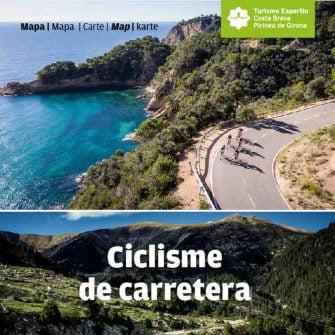 Girona Costa Brava cycling map here
Girona Costa Brava cycling map here Old town Girona (photo credit: footnote 6)
Old town Girona (photo credit: footnote 6)Local bike shops
Nothing beats getting inside and up-to-date tips from a friendly local bike shop as you stock up on energy bars and spares (bike rental stations are also a good bet). So, whether you’re at home or on holiday, it’s worth dropping into the local shop and getting their tips and the most up-to-date information. Many bike shops also have (free!) organised rides that are a sociable way of discovering an area.
It’s even worth asking about local groups – cyclists are a sociable bunch and who knows, you may make some lifelong friends!
Nowhere is this more true than in Girona, as many of the bike shops organise weekly rides that are free to take part in. They’re a great way to discover the area!
- Eat Sleep Cycle – Monday at 10am
- Bike Breaks – Thursday at 10am
- Cicloturisme Tours – Friday at 10am
Note: if you’re travelling while Covid is still a problem, just check in with the shops beforehand to ensure the ride is on that week.
Get a local guide
There is a growing market for expert local guides that know the area intimately and pedal alongside you on the best routes the area has to offer. A good guide will transform your experience with the type of local knowledge that will enrich your riding. They can help you find the cyclist-friendly routes with the minimum of planning effort from you.
Girona’s local tour operators
As a popular cycling destination, Girona has a number of excellent local businesses that will be delighted to provide you with a guide and help you plan your cycling routes and tours in and around Girona:
Catalonia Bike Tours, +24 608 57 68 21, cataloniabiketours.com
Cicloturisme Tours, +34 972 221 047, cicloturisme.com
Eat Sleep Cycle, +34 972 649 131, eatsleepcycle.com
Girona Pro Sport, +34 690 248 632, gironaprosport.com
Trek and Ride, +34 972 28 00 94, cicloturisme.com
Zona BTT Pirineu Girona, +34 605 227 978, zonabtt.com

Local guides around Girona will help you find the best routes (photo credit: footnote 7)

Shop ride in Girona (photo credit: footnote 8)
Part 3: Using the bike route while riding
So, once you’ve got your perfect GPX bike route files, how do you actually use it/them while riding?!
Unless you’ve taken the opportunity to hire a guide or are on take part in a guided tour, and therefore bypass the need to follow a route, these tips should come in handy.
Printed map v GPS device v smartphone
A neatly folded paper map, suitably waterproofed and tucked into your jersey pocket certainly has a certain retro cool. But fumbling with maps with cold fingers while battling the wind and rain (or even sweaty fingers due to a warm sun!) means that your paper maps are probably best left at home. Stopping to unfold a map also eats up valuable riding time.
Using apps like Google Maps or Ride with GPS on your smartphone can be a practical and cost-effective way of making use of the amazing technology of your smart phone. To get the best navigation experience, you’ll need a good mount, waterproofing and protection. Remember though that using GPS and having your screen on will eat your battery life, so you might want to consider having the screen turned off and only switching on for turn by turn instructions.
A cycling computer mounted on your handlebar (or stem) is of course the most stylish and practical way to follow a route. It’s designed for exposure to weather and is much less likely to smash if you inadvertently drop it (we speak from experience!)… While even the latest top-of-the range bike computers have limited ability to create and evolve routes ‘on the fly’, most GPS devices allow you to easily upload a route to follow.
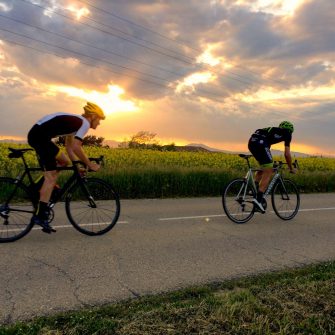 Having your route on a bike computer means more time spent riding, less time fumbling with maps! (photo credit: footnote 9)
Having your route on a bike computer means more time spent riding, less time fumbling with maps! (photo credit: footnote 9) Bike computers will give you your route, plus other useful info like speed, distance and elevation gain
Bike computers will give you your route, plus other useful info like speed, distance and elevation gain
Following the route
We find that a large visual display of the route is the easiest.
Turn by turn instructions
You can either choose to follow turn by turn instructions or just display your location as a dot, with a coloured line showing the route you need to follow. We prefer the turn by turn instructions, because it means you don’t need to think about which turn to take – the app will flag it at the junctions.
Voice navigation
In our experience cycling while listening to audio instructions is extremely difficult (even when you can hear the instructions) and potentially dangerous. We don’t recommend wearing earphones while cycling, even to listen to route instructions.
Helpful navigation tips
Some apps and devices allow you to specify how far in advance you want turn instructions. A distance of at least 50 metres will give you plenty of reaction time.
A good level of zoom on your device will mean you’re not turning off early or getting the wrong exit at the roundabout.
Needless to say, safety is a priority. Make sure your cycling computer or smartphone is mounted where it is clearly visible. Do not be tempted to fiddle or spend too long looking at your iphone while riding. Many a cycling accident has been caused by cyclists distracted by their computer.
And on that note, it’s time to say stay safe and have a fantastic next ride!
Big thanks to Patronat de Turisme Costa Brava Girona for making this article possible.
Remember that Girona is a brilliant cycling destination with cycling routes for all levels and kinds of cyclist. Check our guides to Girona, and the articles below, for more info!
What are your top tips for cycle route planning?
Have we forgotten anything? What are your top tips? Let us know in the comments below!
Want to know more about cycling in Girona?
Don’t miss our tips for easy routes and beginner cycling challenges in Girona.
Also check out our in-depth guide to Girona, which contains route guides, tips for riding in/around Girona and much more!
Photo credits:
Footnote 1: Cap de Creus. Costa Brava. Cycling Tips. Brazo de Hierro. CBGTB Image Archive.
Footnote 2: Costa Brava. The Col Collective. CBGTB Image Archive.
Footnote 3: Santuari dels Àngels. Facu Aguirre. CBGTB Image Archive.
Footnote 4: Banyoles. Facu Aguirre. CBGTB Image Archive.
Footnote 5: Girona. La Fabrica. Jase Wilson. CBGTB Image Archive.
Footnote 6: Girona. Tristan Cardew. CBGTB Image Archive.
Footnote 7: Ripoll. The Col Collective. CBGTB Image Archive.
Footnote 8: Bike Breaks Girona.
Footnote 9: Costa Brava. The Col Collective. CBGTB Image Archive.
Got a question for Clare?
Fill out this form and we will send it to Clare. We aim to get you an answer within 24 hours where possible!The contents of this website are provided for general information purposes only. It is not intended to amount to advice and you should not rely on it. You should carry out your own due diligence and risk assessments and take professional advice. Views expressed by interviewees or other users of this website do not necessarily represent our views. We make no representations, warranties or guarantees, whether express or implied, that the content on our website is accurate, complete or up to date. If you use any information or content on this website, download from, or otherwise obtain content or services through our website, it is entirely at your own discretion and risk. Epic Road Rides Ltd disclaims all liability and responsibility arising from any reliance placed on the information and content on this website. Find out more here.




What about Komoot? Great for road surface & road type checking. Cross referenced to Google Maps at the right zoom level shows clearly the best quieter roads to select, then street view to double check.
In the end, the most important footnote is that time invested in planning, leads to a ride spent enjoying it, not stressing it.
Yep, Komoot is another option! We prefer RWGPS, but each to their own! And agree, it’s all about the planning!